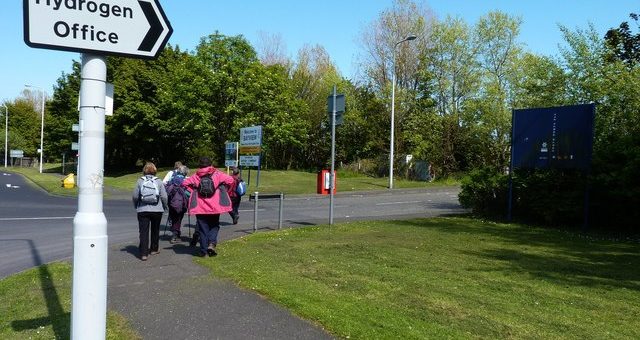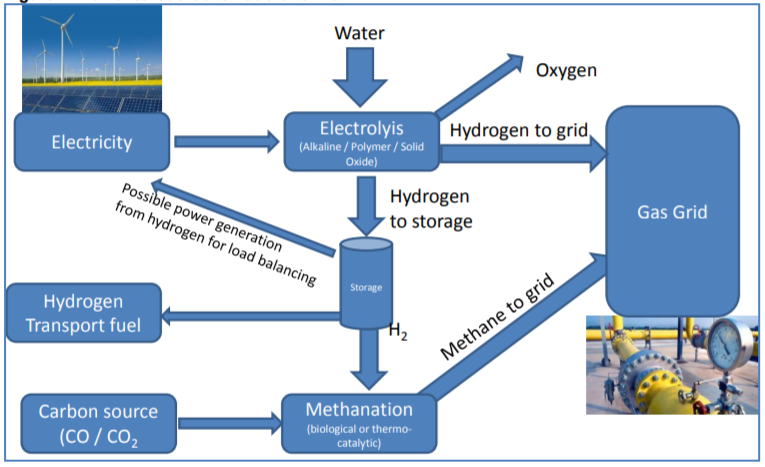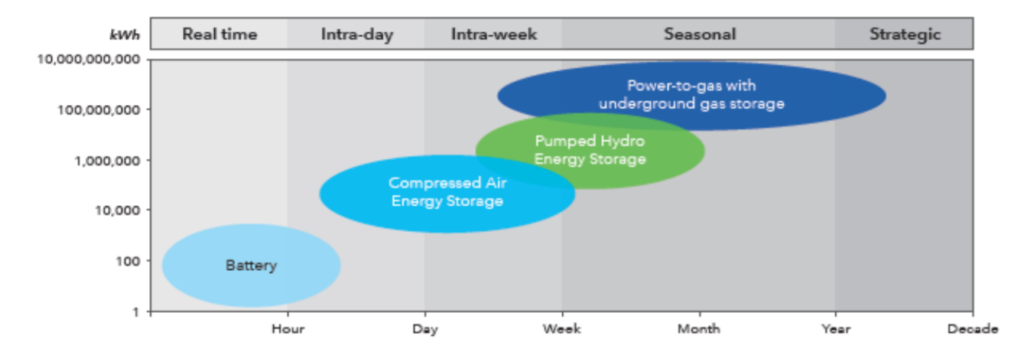
Zero carbon means that we completely stop using fossil fuels (or does it? maybe a topic for a future blog). We can meet all of our energy needs from renewable energy, but a lot of these, e.g. wind and sun, are only available when the weather is right. On the other hand, we want to use energy at certain times of day to shower, cook dinner or work, and when it’s cold to keep ourselves warm. The mismatch between windy and sunny weather on the supply side and dinnertime, netflix time or a cold day on the consumption side is one of the biggest technical challenges we are now facing in the energy system. What can we do about this?
We need to store energy over many different timescales – daily to store daytime solar energy for evening use, seasonally to store summer heat for winter warmth, and everything in between. Many forms of renewable energy generate electricity, but electricity itself cannot be stored (other than in capacitors or superconducting loops). Practically, it needs to be converted to another form of energy for storage, then back to electricity. For example, chemical energy in batteries, or potential energy in pumped hydro storage. Or there’s another chemical conversion: into gas.
Gas can be stored over long periods, and can then be used to generate electricity or directly to heat homes or cook. We already have gas infrastructure – a huge network of pipes underground, boilers and cookers in homes and commercial buildings, small and large storage tanks operated by the network companies. However, the gas used now is mostly ‘natural gas’ – a fossil fuel form of methane, that is extracted alongside oil or coal underground in the North Sea, from Russia, or other parts of the world. This energy source has no place in our zero carbon future.
So what will we do instead? One option is to move completely away from gas, and only use electricity for heat and transport to electricity. We could then use batteries and pumped hydro as storage. The price of batteries has dropped dramatically over recent years, bringing electric cars to the mass market, and allowing electricity storage batteries to be developed at a variety of scales, from household to community to grid. However, batteries only provide relatively short-term storage, and are associated with some serious environmental impacts.
Another option is to make use of the existing gas infrastructure, but to change the gas that we are putting into the network to a combination of methane from biogas and hydrogen or methane produced using surplus electricity at times when the weather is giving us abundance. This gas can be stored over long periods of time, and used directly for heat and transport fuel, or converted to electricity in power stations or using fuel cells.
Let’s think this through. Gas can have several functions in our energy system. It is:
- a versatile fuel – we can get methane (CH4) directly from oil fields or from anaerobic digestion of biogas. Hydrogen has to be manufactured.
- a form of storage – we can store methane or hydrogen in tanks.
- an ‘energy vector’ or means of transporting energy from one place to another – we can transport gas in pipes.
There are several aspects to considering the future of gas:
- do we use methane, which our current infrastructure is designed for, or do we convert to a ‘hydrogen economy’, or use a mixture of the two?
- where do we get our gas from? both hydrogen and methane can come from renewable and non-renewable sources
- what is the best way to use it? do we just use it to store and produce electricity (using the electricity network to transport energy), or do we also pump gas itself from one place to another using the gas pipes?
Hydrogen could fit into the wider energy system as shown below.

Image from Oxford Institute of Energy Studies, Power-to-gas: Linking electricity and gas in a decarbonising world? By Martin Lambert
We need to be careful about where the hydrogen and methane come from. It is possible to make hydrogen from fossil fuel methane, which does not help us from a climate change perspective. So we are only really interested in hydrogen that is produced from renewable sources of primary energy. For example, using renewable electricity in electrolysis to produce hydrogen from water, with oxygen as a by-product.
If we are mixing the hydrogen with methane, or using methane in the system, we can produce methane directly from biogas, using anaerobic digestion of poo and other organic material. We can also produce methane by combining hydrogen (from renewable sources) with carbon dioxide (CO2), which can be captured from the anaerobic digestion process or elsewhere.
Our local gas network operator, Wales and West Utilities, has a very forward-thinking innovation team, who know that a decarbonised energy system could mean their infrastructure becomes redundant. For several years, they have been seriously reflecting on whether they should: a) stop investing in renewing and updating their infrastructure, or b) put their infrastructure to the service of a low carbon energy system by finding new uses for it.
This has led to some very interesting innovation projects. For example, the ‘freedom project’, in partnership with our electricity network operator Western Power Distribution, tested hybrid heating systems which could switch between (methane) gas and electricity depending on weather conditions and the carbon intensity of the electricity at different times of day, to optimise efficiency (this is a great project probably worthy of a separate blog post).
The Leeds Hydrogen City project explored converting existing household gas boilers in sections of the city so that they could burn hydrogen instead of methane.
There are also hydrogen projects closer to home, e.g. Bristol Hydrogen Boats, who are experimenting with using hydrogen for transport.
If we use hydrogen gas, this has great advantages for air quality and reducing pollution, as burning hydrogen for electricity, heat or transport produces only water – imagine car exhaust pipes dripping only clean water and water vapour, instead of particulates, nitrogen oxides and other pollutants that are so bad for our health! However, the amount of hydrogen we can put directly into the current gas grid is limited. As Martin Lambert of the Oxford Institute for Energy Studies puts it.
“Some hydrogen, within certain limits, can be injected into the natural gas grid. Current regulatory standards generally impose very low limits on the amount of hydrogen in the gas grid (for example the UK limit is 0.1 per cent by volume, and Netherlands between 0.02 and 0.5 per cent). There is a growing consensus that a higher hydrogen content, certainly up to one per cent and in some cases as high as five per cent, could be accommodated without impact on the gas grid or end user equipment. … the HyDeploy project at Keele University in the UK, contemplating up to around 20 per cent hydrogen”
The potential for hydrogen to be a clean and elegant solution for energy storage is really exciting. In particular, hydrogen from electricity, or ‘power to gas’, can be used to store much larger amounts of energy for much longer than batteries, as shown below.

The main downside is the financial cost. Methane produced from hydrogen using renewable electricity is more expensive than methane produced from biogas. There are still many questions to be answered, such as whether power to gas should focus on producing hydrogen or methane, whether the gas is used simply as storage in the electricity system or put into the gas network or used for transport or industry. If we do put hydrogen in the existing gas network, this has safety, technical and operational issues, such as changing all of the boilers in homes to take hydrogen instead of methane, and potential reduction in life of steel pipes.
What could this mean for the West of England? We could carry out a West of England hydrogen gas study similar to that used in Leeds. We could identify how much hydrogen we could produce from local renewable energy, and how long that would last as storage. We could identify sites within the West of England where gas could be stored, or understand where on the wider gas network our nearest storage would be. We could work with biogas producers and Wales and West Utilities to trial different integrated gas/electricity/biogas projects, and identify any other renewable energy generation sites that could potentially produce hydrogen. At the same time, we could identify industrial and transport uses where hydrogen or methane would be more suitable than electricity.
Martin Lambert’s paper for the Oxford Institute for Energy Studies is a good starting point for more detailed information: https://www.oxfordenergy.org/wpcms/wp-content/uploads/2018/10/Power-to-Gas-Linking-Electricity-and-Gas-in-a-Decarbonising-World-Insight-39.pdf

